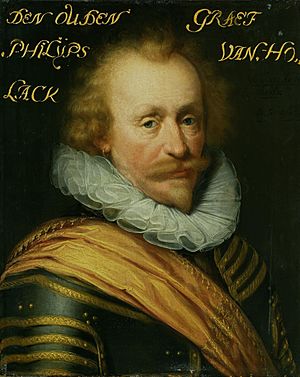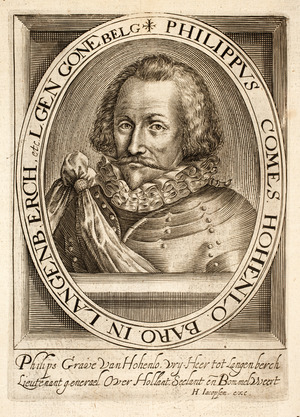Philip of Hohenlohe-Neuenstein facts for kids
Philip of Hohenlohe-Neuenstein (born February 17, 1550 – died March 6, 1606) was a German count. He became an important army commander. Philip served the Dutch Republic. He was the son of Ludwig Kasimir von Hohenlohe-Waldenburg and Anna zu Solms-Lich. On February 7, 1595, he married Maria of Nassau. They married in Buren. They did not have children of their own. Shortly before he died, Philip adopted a nine-year-old girl named Margrita Maria. She was the Countess of Falckenstein.
Contents
Philip's Life and Military Career
Philip of Hohenlohe was also known as Hollock. He started working for William I of Orange in 1575. William I was a very important leader in the Netherlands. Philip became William's Lieutenant-general in Holland. This meant he was a high-ranking military officer.
Key Military Victories
Philip was a skilled commander. He led his troops to many victories. In 1576, he captured Geertruidenberg. The next year, 1577, he took Steenbergen. He also conquered Tholen and Breda. Later, he captured places like Mengen and Gennep in 1599. In 1590, he built a fort near 's-Hertogenbosch. This fort helped protect the area.
Leadership After William of Orange
William of Orange was sadly assassinated in 1584. Philip's experience was very valuable. The States of Holland asked him to stay on as lieutenant-general. William's son, Maurice of Orange, was still quite young. He was not ready to lead the army yet. Philip was known for being brave. He was a bold commander.
Relations with Maurice of Orange
As Maurice grew older, he became the captain-general of the Republic. This meant he was the main military leader. Over time, Philip's relationship with Maurice became difficult. Maurice felt that Philip was not always reliable. He also thought Philip was not good at keeping secrets.
There was also a personal reason for their disagreements. In 1582, Philip had asked William of Orange for permission to marry his oldest daughter, Maria of Nassau. The marriage had been delayed because of money problems.
Marriage and Inheritance Dispute
After William's death, there was a disagreement over his possessions. William's rightful heir was Philip William of Orange. But he was held captive in Spain. Maria had managed William's belongings since 1584. After the siege of Breda, Maria seemed to have enough money. So, the marriage could finally happen.
After their marriage, Philip was expected to control a large part of William's inheritance. Maurice did not agree with this. In 1591, the States-General divided the possessions. Maria of Nassau received the county of Buren. Maurice received the rest. Years of legal arguments did not change this. Philip and Maria finally married in 1595.
Later Years and Retirement
Philip served under Maurice during a military campaign in 1597. He also fought during the Siege of Groenlo. However, after his marriage, Philip became more and more isolated. Maurice gave him fewer commands in the army. Things got worse in 1600. Maurice removed him from his position as lieutenant-general of Holland and Zeeland.
In 1604, Philip became ill. He started to show signs of paralysis. He passed away on March 6, 1606, in IJsselstein. His wife took his body to Öhringen (Baden-Württemberg). He was buried in the family tomb. This was in the collegiate church of St. Peter and St. Paul. The burial took place on November 5, 1606.
Sources
- Deursen, A.Th. van (2000) Maurits van Nassau. De winnaar die faalde. Amsterdam: Bert Bakker. ISBN: 90-351-2284-4
- Swart, E. Filips van Hohenlohe in De Tachtigjarige Oorlog. De opstand in de Nederlanden.
- Swart, E. (2007) Maria van Nassau in Digitaal Vrouwenlexicon van Nederland . Instituut voor Nederlandse Geschiedenis.
See also
 In Spanish: Felipe de Hohenlohe-Neuenstein para niños
In Spanish: Felipe de Hohenlohe-Neuenstein para niños 



